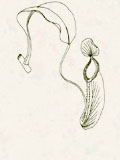

|
|
News from DEB (pdf)
2005 seems set to become the ‘Year of Biodiversity’ if present indications are anything to go by. Already we have faced the invasion of the killer Fire Ants (Solenopsis invicta), which is already well established on the mainland New Territories, and faced the spectre of Giant Anteaters wandering down Nathan Road. But seriously, the idea that we should introduce exotic anteaters to control invasive ants makes little sense, especially when we have ant-eating Pangolins existing locally. Perhaps this suggestion reflects a broader lack of awareness about Hong Kong’s native biodiversity, as I doubt many senior government officials would recognise a Pangolin if they were fortunate enough to meet one on a dark night. My initial reaction to the S. invicta scare was to assume that someone had made an error, and confused exotic S. geminata with its more obnoxious relative. Solenopsis geminata was first recorded in Hong Kong in the 1930s, and was still here when John Fellowes studied local ants for his PhD in the 1990s, so it is safe to assume that it has become naturalized. After some delay, however, the identification of S. invicta was confirmed. My second reaction to the invasion was to wonder if we could study the impacts of Fire Ants on native biodiversity. Such an investigation would require a comparison of infested and ant-free areas, and I doubt that we could justify allowing an infestation to persist just we that we could look at its effects. So, could government have done anything to prevent the invasion? I think the answer is ‘not much’. The Fire Ants were in Guangdong for some time before their presence was announced and, given the number of colonies detected here, it seems likely that they were transported into Hong Kong with ornamental plants well before the alarm was raised in the run-up to Chinese New Year. A quick response from government aimed at eradicating established colonies was what was needed and what, in fact, happened.
A second biodiversity issue that has been receiving some attention is government’s ongoing consultation process on measures to protect local marine fisheries. Views on this vary: some feel that the annual summer moratorium on fishing should be lifted (although there are no signs that China will make such changes to fishery regulations that apply to neighbouring waters) while, at the other end of the spectrum, there have been suggestions that all of Hong Kong’s territorial waters be designated a ‘no take’ zone. There is an almost infinite variety of compromise positions that might or might not involve licensing schemes for commercial fishers. The key point is that debate has been initiated because (at last) someone in authority has not only noticed that the existing situation is unsustainable but has decided that something must be done to improve things.
And then there is the recently-announced Lantau Concept Plan … With regard to that, space (and, perhaps, politesse) does not allow me to comment. Instead, I have one other thing to report. At the end of 2004, a new Research Assistant Professor, Dr Yixin Zhang, joined DEB. Yixin did his PhD at Umea University in Sweden, and has since worked at the University of California in Santa Barbara and the University of British Columbia. He is a stream biologist, and will be spending his three years with us looking at land-water interactions, and their relevance for conservation and management. Yixin introduces himself elsewhere in this issue of Porcupine!
All that remains is for me to wish readers of Porcupine! a healthy and prosperous – albeit belated - Year of the Rooster.
 |
|
Fire ant nests in Long Valley: the nests are unique in Hong Kong. (Photo: Billy Hau) |
P.3
|
Porcupine! |
 Copyright © 2000 |
